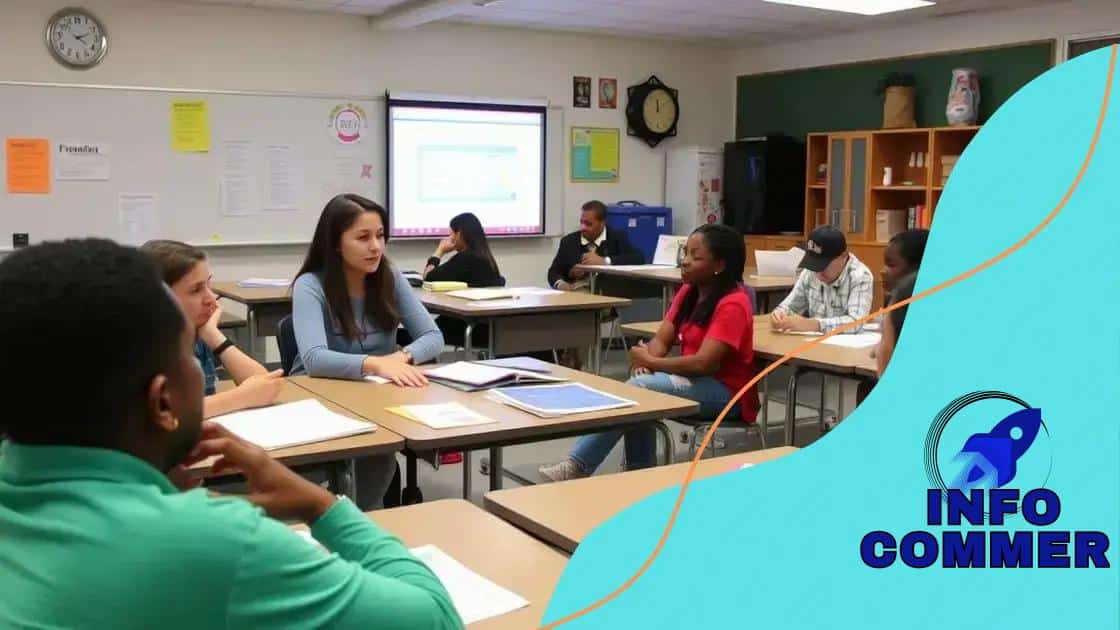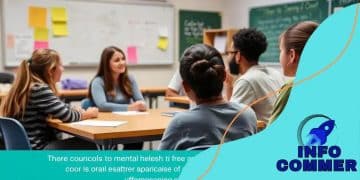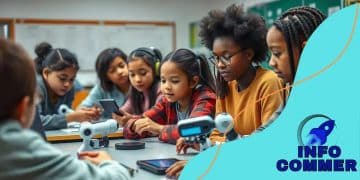Financial literacy programs in middle and high schools: a must

Financial literacy programs in middle and high schools equip students with essential money management skills, enabling them to make informed financial decisions that positively impact their futures.
Financial literacy programs in middle and high schools play a crucial role in shaping young minds. Have you ever wondered how these programs can influence students’ future financial decisions? Let’s dive into the essentials.
Importance of financial literacy
Financial literacy is essential for everyone, especially young students. Understanding how to manage money can help shape their futures, giving them the skills needed for making informed decisions. It equips them to navigate challenges like budgeting, saving, and investing.
Why Is Financial Literacy Important?
When students learn about money, they are better prepared to face financial responsibilities. This knowledge empowers them and fosters a sense of security. Strong financial skills lead to healthier habits and reduce the likelihood of debt.
Moreover, financial literacy allows teens to:
- Make informed spending choices.
- Understand credit and loans.
- Plan for future expenses.
- Recognize the significance of saving for emergencies.
As students grasp these concepts, they become more confident in managing their finances, which is critical for independent living. It’s not just about money; it’s about fostering a mindset geared for success.
Integrating financial literacy into school curricula creates a platform for positive change. Schools that prioritize this education help cultivate responsible citizens who are aware of their economic impact.
Long-Term Benefits of Financial Literacy
The benefits of strong financial skills extend far beyond school. Students who are financially savvy:
- Are more likely to build wealth over time.
- Have better credit scores as adults.
- Make smarter investment decisions.
This leads to greater financial stability and personal empowerment. In today’s complex financial landscape, being informed is key to thriving. Embracing financial literacy means embracing a brighter future.
Key components of effective programs
Effective financial literacy programs share several key components that ensure students are well-equipped for real-world challenges. Understanding these components is crucial for creating a meaningful educational experience.
Engaging Curriculum
The first critical component is an engaging curriculum. Programs should include interactive lessons that capture students’ attention, making learning about finances exciting. This can involve using games, real-life scenarios, and technology to facilitate learning.
- Incorporate hands-on activities.
- Use technology like apps for tracking expenses.
- Relate lessons to students’ lives.
By making the material relevant and relatable, students are more likely to absorb and retain financial knowledge.
Qualified Instructors
Another essential element is having qualified instructors. Educators should not only be knowledgeable about financial topics but also skilled in teaching. A good instructor can inspire students and help them grasp complex concepts with ease.
It’s beneficial when teachers actively engage with students and encourage questions. This approach fosters a safe environment for discussion. Additionally, professional development for instructors can enhance their effectiveness in delivering financial literacy education.
Real-World Applications
Real-world applications of financial concepts are vital for comprehension. Students should learn how to apply what they have learned to their daily lives. This can include budgeting, managing expenses, and understanding credit.
- Use case studies to illustrate financial scenarios.
- Encourage project-based learning.
- Provide opportunities for students to create budgets.
When students can see the application of their knowledge, they are more likely to recognize its importance.
Assessment and Feedback
Lastly, assessment and feedback play important roles in effective programs. Regular assessments help gauge students’ understanding and identify areas needing improvement. Feedback encourages growth and keeps students engaged in their learning process.
Often, combining formative and summative assessments can offer valuable insights into each student’s progress. This way, adjustments can be made to the program as needed, ensuring all students benefit from financial literacy education.
How schools can implement these programs

Implementing financial literacy programs in schools requires careful planning and execution. Schools can take several strategic steps to ensure that students receive this important education effectively.
Assessing Needs and Resources
The first step is for schools to assess their specific needs and available resources. This involves analyzing the current curriculum to identify gaps in financial education. Engaging with the community can help gauge interest and support for financial literacy initiatives.
- Conduct surveys among students and parents.
- Review existing programs and materials.
- Identify potential community partners for resources.
Understanding these factors helps shape a tailored program that meets student needs.
Developing a Curriculum
Once needs are assessed, developing a relevant curriculum becomes essential. The curriculum should align with educational standards while being engaging and practical. Including various teaching methods like workshops, projects, and real-life applications can enhance the learning experience.
Incorporating topics like budgeting, saving, investing, and understanding credit will provide students with a robust understanding of personal finance.
Training Teachers
Another critical step involves training teachers to deliver financial literacy effectively. Teachers must be comfortable with financial concepts and skilled in pedagogical strategies. Providing professional development opportunities can equip them with the necessary tools to teach this subject.
- Offer workshops on financial topics.
- Provide resources like lesson plans and materials.
- Encourage collaboration among educators to share best practices.
When teachers feel confident, they can engage students better and create a dynamic learning environment.
Creating Partnerships
Creating partnerships with local banks, financial institutions, and nonprofits can also enhance the program. These organizations often have resources, expertise, and programs that can supplement schools’ offerings.
Inviting guest speakers and arranging field trips can help bring financial concepts to life, making learning more enjoyable and practical.
Evaluating and Adapting Programs
Finally, it’s crucial to evaluate the programs regularly and adapt them as necessary. Schools should collect feedback from students and educators to assess the effectiveness of the curriculum. Adjustments might be needed based on student performance and engagement levels.
- Conduct regular assessments of student understanding.
- Gather feedback to improve curriculum content.
- Update resources as needed based on current financial trends.
This commitment to growth ensures that financial literacy remains relevant and impactful for students.
Engaging teaching methods
Engaging teaching methods are crucial for making financial literacy programs effective. When students find learning enjoyable, they are more likely to recall important information and apply it in real life.
Interactive Learning Activities
One great way to engage students is through interactive learning activities. Using games and group projects fosters collaboration and reinforces key concepts. Activities like budgeting games or mock stock market simulations can be both fun and educational.
- Incorporate role-playing scenarios.
- Develop team competitions with financial scenarios.
- Use technology for interactive simulations.
These interactive methods help students visualize financial processes and develop critical thinking skills.
Real-Life Financial Scenarios
Another effective approach is incorporating real-life financial scenarios into lessons. By discussing everyday financial decisions, students can see the relevance of what they are learning. Examples can include planning a budget for a school trip or comparing prices when shopping.
These relatable situations make abstract concepts tangible. When students can connect classroom lessons to their lives, they retain information better. It also encourages them to practice these skills outside the classroom.
Use of Technology
Integrating technology into lessons can greatly enhance student engagement. For instance, using apps for budgeting or financial tracking can provide hands-on experience. Many educational tools offer engaging ways to explore financial topics, allowing students to learn at their own pace.
- Utilize financial literacy apps in class.
- Incorporate online resources and videos.
- Encourage students to create digital presentations on financial topics.
By embracing technology, educators can reach students in ways that resonate with them, making learning more relevant and exciting.
Guest Speakers and Workshops
Inviting guest speakers from financial institutions or community organizations can provide students with valuable insights. These experts can share real-world experiences, making lessons more impactful. Workshops led by professionals help students visualize potential careers in finance and understand practical applications of their education.
Having these interactions enhances students’ understanding of financial concepts while also providing networking opportunities.
Measuring success and impact
Measuring the success and impact of financial literacy programs is essential to ensure they effectively educate students. Tracking progress helps schools refine their methods and understand what works best for their students.
Setting Clear Goals
The first step in measuring success is to establish clear and achievable goals for the program. These goals should outline what students are expected to learn and how their financial knowledge will grow. This can include specific skills like budgeting or understanding credit.
- Define target competencies for each grade level.
- Set timelines for expected student progress.
- Involve students in setting personal financial goals.
By having clear objectives, educators can easily track advancements and adjust teaching strategies as needed.
Using Assessments
Regular assessments provide valuable insight into students’ learning. Schools can use a mix of formative assessments, like quizzes and class discussions, along with summative assessments, such as final projects or exams. These evaluations can show how well students grasp key concepts.
Incorporating pre- and post-tests can highlight knowledge gains over time, demonstrating the program’s effectiveness.
Feedback from Students
Gathering feedback from students is another critical measuring tool. Surveys and discussions can help educators understand students’ experiences and perceptions of financial literacy lessons. This input can guide program improvements and adjustments.
- Ask students to reflect on their learning experiences.
- Use anonymous surveys to gather honest opinions.
- Encourage students to share their financial learning applications.
When students feel their voices matter, they are more likely to engage actively in the learning process.
Long-term Tracking of Financial Habits
Measuring success goes beyond immediate assessments. Long-term tracking of students’ financial habits can determine the program’s lasting impact. Schools can follow up with students after graduation to see how their financial literacy translates into their adult lives.
Tracking data on savings accounts, investment strategies, or debt management can provide insights into how well students apply what they learned in school.
Community Engagement Metrics
Lastly, evaluating community engagement is vital. Many effective programs involve partnerships with local businesses and organizations. Tracking how these partnerships develop and grow can indicate the program’s influence and success.
- Measure the number of community events held.
- Gather data on community participation in programs.
- Assess partnerships’ sustainability and growth over time.
This holistic approach ensures that financial literacy programs not only teach students but also positively influence the wider community.
In summary, financial literacy programs in middle and high schools play a crucial role in preparing students for their futures. These programs equip young people with essential skills to manage money wisely, understand financial concepts, and make informed decisions. By implementing engaging teaching methods, assessing progress, and adapting to feedback, schools can create effective programs that truly impact students’ lives. As we invest in financial education, we also invest in the prospects of our future leaders, helping them navigate their financial journeys with confidence.
FAQ – Financial Literacy Programs in Middle and High Schools
Why are financial literacy programs important for students?
Financial literacy programs equip students with vital money management skills, helping them make informed financial decisions now and in the future.
What are some effective teaching methods for financial literacy?
Engaging teaching methods include interactive activities, real-life scenarios, and the use of technology to make learning relatable and fun.
How can schools measure the success of financial literacy programs?
Schools can measure success through assessments, feedback from students, and long-term tracking of students’ financial habits after graduation.
What role do community partnerships play in these programs?
Community partnerships provide valuable resources, guest speakers, and real-world insights, enhancing the educational experience for students.





